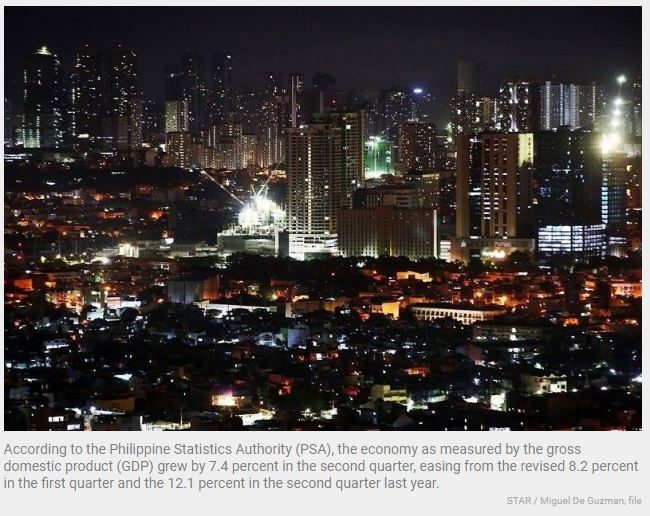Philippines: Economic growth slows in 2nd quarter
MANILA, Philippines — The Philippine economy expanded at a slower pace in the second quarter, but the government is still confident the growth target for the year can still be achieved.
According to the Philippine Statistics Authority (PSA), the economy as measured by the gross domestic product (GDP) grew by 7.4 percent in the second quarter, easing from the revised 8.2 percent in the first quarter and the 12.1 percent in the second quarter last year.
On a quarterly basis, the GDP declined by 0.1 percent in the second quarter.
“I think the global headwinds, particularly inflation, such as those coming from energy, fuel and food contributed to the slowdown,” Socioeconomic Planning Secretary Arsenio Balisacan said.
He said the easing of alert levels, removal of tourism restrictions and accelerated vaccine rollout have helped increase the country’s economic activities.
National Statistician Dennis Mapa said all major economic sectors posted positive growth in the second quarter. In particular, services grew 9.1 percent, industry expanded by 6.3 percent and agriculture, forestry and fishing rose 0.2 percent.
While global headwinds are expected to remain in the second half, Balisacan said these have already been factored in by the government when it revisited its growth projection of 6.5 to 7.5 percent for the year.
He said that while the 7.4 percent second quarter GDP growth was slightly lower than the median forecast of 7.5 percent, it still placed the country as the second best performing nation among the region’s emerging economies that have released their economic performance reports during the period.
In particular, he said the country is only behind Vietnam’s 7.7 percent growth, but ahead of Indonesia’s 5.4 percent and China’s 0.4 percent.
“This performance also remains in line with our expectations or our expected 6.5 to 7.5 percent growth in 2022,” he said.
With GDP growth for the first half at 7.8 percent, Balisacan said the economy would just need to grow 5.3 percent in the second semester to achieve the lower end of the growth target for the year of 6.5 percent.
“On the other hand, to achieve the 7.5 percent, we need to grow something like 7.2 percent. So it is very likely we will be able to achieve that,” he said.
For ING Bank Manila senior economist Nicholas Mapa, the second quarter GDP report points to full year growth settling at the lower end of the government’s 6.5 to 7.5 percent.
“The economy is facing the triple threat of accelerating inflation, rising borrowing costs and a relatively high debt-to-GDP ratio,” he said.
He said the faster inflation rate, which was last reported at 6.4 percent in June, is expected to cap overall household spending, while rising interest rates are likely to put off investment outlays.
In addition, he said the high debt level could limit the government from providing stimulus in the near term.
For his part, Rizal Commercial Banking Corp. chief economist Michael Ricafort said the economy could expand by an average of 6.5 to seven percent, or even above seven percent this year, in view of the lower base, as the economy reopened further this year compared to last year when lockdowns were still imposed.
He said major economic drivers for the rest of the year include: measures to further reopen the economy, increased government spending especially on infrastructure, the Corporate Recovery and Tax Incentives for Enterprises Law, and accommodative monetary policy.
“Going forward, the biggest economic growth driver would still be any additional measures to reopen the economy as justified by increased vaccination/booster shots towards population and eventually herd immunity,” he said.
Balisacan said the government is committed to pursuing the country’s full reopening, including the return of face-to-face schooling to address the learning losses and increase domestic activities.
He said part of the push would be to increase the booster uptake, with the Department of Health aiming to boost 50 percent of the 78 million target population within the first 100 days of the Marcos administration.
“This move will allow more areas to de-escalate to alert level 1 and, eventually, the complete removal of restrictions that hinder economic activity,” he said.
Balisacan said the full reopening of the economy is expected to generate more opportunities to earn income.
He said the government would work to ensure food security and reduce transport, logistics, and energy costs.
Source: https://www.philstar.com/business/2022/08/10/2201480/economic-growth-slows-2nd-quarter


 English
English




